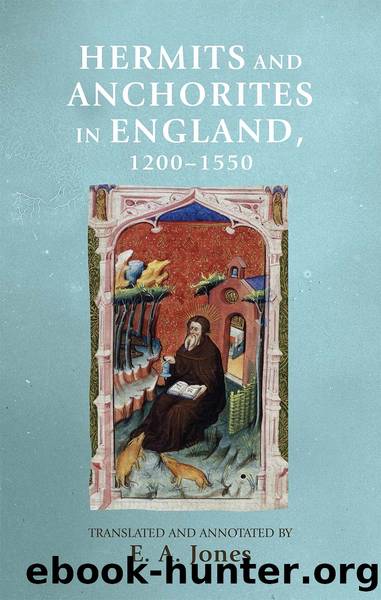Hermits and Anchorites in England, 1200â1550 by E.A. Jones

Author:E.A. Jones
Language: eng
Format: epub
Publisher: Manchester University Press
VI: RULES AND REGULATION
Introduction
Some time in the 1320s the young Yorkshireman Richard Rolle dropped out of Oxford and returned home. Soon afterwards, he took two of his sisterâs dresses and his fatherâs rainhood to a nearby wood and, with a bit of amateur tailoring, fashioned a kind of habit for himself. Putting it on, he arrived at âa confused likeness to a hermitâ [47]. The anecdote makes it clear that Rolle knows what a hermit ought to look like, even if his improvised attempts fall comically short. But equally, there is no sense that he might or should have proceeded differently. With no accepted procedure to follow, the early fourteenth-century hermit marked his transition to a new state of life as best he could.
Chapter I of this volume offered evidence for the enquiries and deliberations, the official processes and procedures, and finally the liturgical ceremonial that were involved whenever an individual expressed the intention of becoming an anchorite. By the end of the Middle Ages, a comparable framework was in place for the vocation of hermit, though only as a much more recent development. A system of episcopal scrutiny and supervision of potential anchorites seems to have existed by the end of the twelfth century, and provides a context for the well-known anchoritic rules (Aelredâs, and the Ancrene Wisse) that also belong to approximately this period. But there is little evidence for any concerted attempt to put hermits on a similarly well-ordered and orderly footing before about 1400. Thereafter, however, things moved quickly and, had Rolle been born a century later, his reception into the eremitic life could have looked strikingly different.
Long associated with the uncompromising repression of heresy, the early fifteenth century is now recognised for its movement of orthodox reform, which saw (amongst other developments) a monastic revival and a renewal of the liturgy.1 We have already seen evidence of increased scrutiny of potential anchorites in this period (see Chapter I, especially [2]), and the attention paid to the solitary vocations in the early fifteenth century may belong alongside these other reformist initiatives. That the curious case of Adam Cressevill, a hermit who had contracted a marriage, was entered into Archbishop Thomas Arundelâs register in 1405 [51] might suggest an interest within his administration in questions around hermitsâ legal status. The next decades saw a more formal role for bishops in assessing and approving candidates for the vocation, the development of a new liturgical rite for hermitsâ profession, and the composition of a number of rules, ranging in character from the entirely rudimentary to the more spiritually advanced.
Like the rite for the enclosing of anchorites, a hermitâs profession had to be conducted by a bishop or his designated representative [48], [49]. It was a relatively simple affair, incorporated within the celebration of the mass of the day, as monastic professions were, and with none of the rhetorical and symbolic elaboration of the corresponding rite for anchorites [5]. The two essential elements are the hermitâs vow, which is both made orally and recorded in writing, and his vesting in the habit of a hermit.
Download
This site does not store any files on its server. We only index and link to content provided by other sites. Please contact the content providers to delete copyright contents if any and email us, we'll remove relevant links or contents immediately.
| Africa | Americas |
| Arctic & Antarctica | Asia |
| Australia & Oceania | Europe |
| Middle East | Russia |
| United States | World |
| Ancient Civilizations | Military |
| Historical Study & Educational Resources |
Magic and Divination in Early Islam by Emilie Savage-Smith;(1462)
Ambition and Desire: The Dangerous Life of Josephine Bonaparte by Kate Williams(1286)
Bohemians, Bootleggers, Flappers, and Swells: The Best of Early Vanity Fair by Bohemians Bootleggers Flappers & Swells- The Best of Early Vanity Fair (epub)(1265)
Papillon by Henry Charrière(1264)
Twelve Caesars by Mary Beard(1148)
Operation Vengeance: The Astonishing Aerial Ambush That Changed World War II by Dan Hampton(1113)
What Really Happened: The Death of Hitler by Robert J. Hutchinson(1076)
London in the Twentieth Century by Jerry White(1054)
Time of the Magicians by Wolfram Eilenberger(1031)
Twilight of the Gods by Ian W. Toll(1027)
The Japanese by Christopher Harding(1025)
Lenin: A Biography by Robert Service(986)
The Devil You Know by Charles M. Blow(935)
Freemasons for Dummies by Hodapp Christopher;(891)
A Social History of the Media by Peter Burke & Peter Burke(885)
Napolean Hill Collection by Napoleon Hill(861)
The Churchill Complex by Ian Buruma(859)
The Rise and Triumph of the Modern Self by Unknown(855)
Henry III by David Carpenter;(854)
